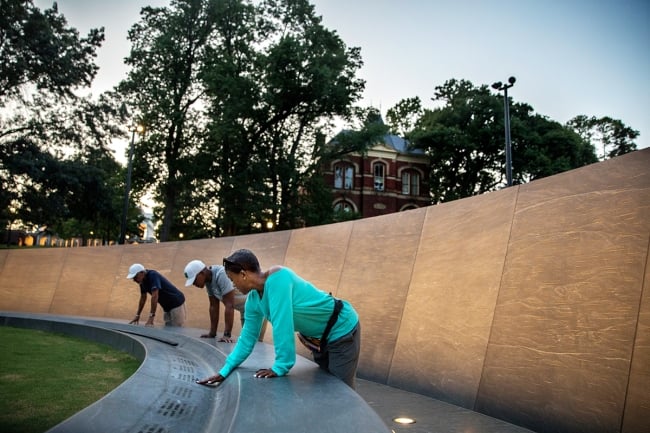You have /5 articles left.
Sign up for a free account or log in.

Three Black alumni visit the University of Virginia’s Memorial for Enslaved Laborers, erected in 2020 to acknowledge the slave labor that built the university.
Evelyn Hockstein/The Washington Post via Getty Images
As the Supreme Court debated whether to strike down affirmative action last spring, Justice Brett Kavanaugh posed a surprising question to an expert witness: Should a benefit given to descendants of slaves—whether a cash payment or something less concrete, like preferential treatment in college admissions—be considered race-based?
Kavanaugh concluded that it should not. Though most, if not all, of the descendants of enslaved people in the U.S. are Black, having a personal connection to historical wrongdoing would technically be a race-neutral factor, Kavanaugh reasoned, and thus fair game for consideration in admissions.
Legal experts and higher education scholars are now weighing the same question in their search for strategies to fill the hole left by the Students for Fair Admissions decision. Kevin Brown, a professor at the University of South Carolina who specializes in the intersection of race, law and education, says affirmative action was first conceived in the 1960s as a kind of reparations; returning to that justification could be one viable post-SFFA strategy.
It’s not entirely untraversed terrain. In 2016, Georgetown University announced that it would give preferential treatment, akin to what legacy prospects receive, to applicants descended from the 273 people who were enslaved and later sold by what was then the Maryland Province of Jesuits. The university also set up multimillion dollar funds to find those descendants and help support them, but what makes Georgetown’s effort unique is the admissions preference it offers.
That approach could gain broader appeal in the wake of the affirmative action ban. In August, the University of Virginia announced a similar, though less formal, new policy: in lieu of a checkbox for legacy applicants, it would offer space for an optional essay on a student’s “personal or historical connection” to the university, which could mean having an alumni parent or being “a descendant of ancestors who labored at UVA.”
Brown said the more narrowly defined an admissions reparations program is, the more likely the courts will be to see it as a compelling, race-neutral interest. He doesn’t expect such programs to go unchallenged, or to suddenly proliferate among liability-shy institutions. But he does believe they have a shot.
“The more targeted it is, the more defensible,” he said. “What UVA did was, like Georgetown, narrow it down to those who worked on the campus; their argument will be strictly remedial … it’s a calculated gamble, and it’s going to be interesting to see how that plays in the courts.”
Grappling With the ‘Legacy’ of Slavery
Many universities, especially older ones, have a complicated history with both slavery and formalized racial discrimination. Institutions including Harvard and the University of Maryland have embarked on research projects to explore those ties. UVA—one of the oldest universities in the country, nestled in the heart of plantation-rich Virginia—was constructed and maintained partly by enslaved laborers.
In 2013, UVA launched the President’s Commission on Slavery and the University to study the institution’s ties to slavery. That commission expanded into a consortium which now boasts over 100 members across the globe.
Kirt von Daacke, a UVA history professor who has led the commission since its founding, said it wasn’t until the 2017 Unite the Right rally in Charlottesville—just outside UVA’s doorstep—that the university began to turn the initiative’s findings into policy.
“That was the big turning point,” he said. “This had always been a truth-telling mission, but we recognized we couldn’t be a 21st-century university without first recognizing our deep complicity in human bondage and in anti-Black racism for decades after the Civil War.”
In 2020, the university finished construction of a Memorial to Enslaved Laborers, acknowledging and honoring the slaves who built the university. The following year Virginia’s then-governor Ralph Northam signed a law requiring the five public universities in the state that were founded before the end of the Civil War to create scholarship funds for descendants of Virginia slaves.
The introduction this fall of legacy preferences for descendants of slaves could be seen as a voluntary expansion of that mandate into the realm of admissions. Some have criticized the new policy for its vagueness, as well as for lumping the descendants of slaves in with legacy applicants, some of whom may have families whose wealth derives from the plantations where those slaves labored.
The essay question is a “blunt tool” for diversifying the student body, von Daacke acknowledges, and he said he understands the criticism. At the same time, he noted that it’s more than many colleges are doing.
“It’s a good sign that we’re not shying away from this issue,” he said. “Anything universities can do to show a commitment to diversity post-SFFA, they should do it.”
The reparations initiatives by UVA and Georgetown make for a useful comparison. One is a public institution whose efforts must be approved by elected officials; the other is a wealthy private university in liberal Washington D.C., with ample resources and the leeway to pursue atonement as its leaders see fit.
That difference explains the gap between their strategies, von Daacke says.
“We have to work within the limitations of the Supreme Court and Fourth Circuit Court decisions and the political realities as a public institution,” he said.
It’s not only 18th-century campuses in the deep South that are grappling with their historic links to slavery. Princeton University’s first eight presidents personally owned slaves. Rensselaer Polytechnic Institute, founded in 1824 in upstate New York, was established largely on donations from a wealthy Dutch slaver, von Daacke said. Just last week Harvard University announced a “Legacy of Slavery” grant initiative, spurred by a 2022 report on the university’s ties to the slave trade.
“Almost any institution in America founded before 1865 is in some way connected to the history of slavery, with the exception of a handful of abolitionist colleges like Oberlin,” von Daacke said. “It’s just more direct in the south.”
From Remediation to ‘Diversity’ … and Back Again?
Gary Orfield, co-founder of the Civil Rights Project at the University of California, Los Angeles, where he also teaches education and law, has been in higher ed long enough to see the full life cycle of affirmative action.
It was born in the mid-1960s, he said, in the wake of the Brown v. Board of Education Supreme Court decision, which outlawed segregated public schools. Some higher education institutions, seeing woefully low nonwhite enrollment, proactively sought to admit more students of color—and Black students in particular—by establishing policies to give preference to those applicants, explicitly citing their historical exclusion from American higher education.
Orfield said that initiative was driven by a rising consensus that higher education had a central role to play in alleviating racial disparity, which was evident in his earliest jobs in academia. At UVA, where he was an assistant professor in the late 1960s, Black students made up less than one percent of the student body; at the University of Illinois Urbana-Champaign, where he held his first tenured position in the mid-1970s, the Ku Klux Klan was an official student organization.
“Almost everybody believed that diversity was beneficial and good,” he said. “But the basic motivation clearly was about civil rights and racial justice.”
In the landmark 1978 case Regents of the University of California v. Bakke, the Supreme Court deemed it unlawful for public universities to set racial quotas. An applicant’s race could only be considered as part of a broader effort to diversify campuses in the interest of all students’ educational enrichment.
That remained the legal framework for affirmative action for nearly a half-century, until the Supreme Court overturned it in June. Now neither remediation for racial oppression nor diversity as an abstract value are considered compelling interests for admissions preferences.
“[The Supreme Court] explicitly ruled out affirmative action on the basis of historic inequality. Even though that was the reason a lot of higher education institutions implemented affirmative action, that was not the justification the court accepted,” said Orfield, who is also the author of The Walls Around Opportunity: the Failure of Colorblind Policy for Higher Education (2022, Princeton University Press). “Now we’re coming to an era after affirmative action, in which everybody’s trying to think of some way to accomplish the same goals without falling into the proxy trap.”
Orfield said that if it passes legal muster, admissions based on reparations would be an improvement on affirmative action, empowering institutions to directly confront the inequality that affirmative action only implicitly addressed for decades.
“Almost everyone who is seriously involved in Civil Rights has, since the Bakke decision, been uncomfortable with the limits of the diversity rationale,” Orfield said. “We have an ugly history of discrimination in higher education that is not widely known, but has been so fundamental to shaping the racial experience in this country … that should be named and recognized, and that’s what affirmative action should be responding to.”
But in order to make the case for narrower remedial admissions preferences, Brown said institutions would first have to confess their complicity in the oppression of minority ethnic groups. That could be a hard sell, especially in states where institutional efforts to confront difficult racial histories have been the source of mounting political tension.
“The places where you’re going to have most of that discrimination are going to be in the South in the red states, who I suspect would be less amenable to these kinds of programs,” said Brown, who lives and teaches in South Carolina—where anti-DEI and anti-CRT bills were introduced this year. “I’d be surprised if legislators here would allow that.”
Brown added that if preferential admissions as remediation for slavery has legal viability, then policies predicated on other historical injustices might, too—as long they’re specific. Private colleges that once excluded certain racial groups—like Emory University in Atlanta, which admitted its first Black undergraduate in 1963—could point to that history as a “compelling interest” for giving such groups preference now, creating a patchwork of institutional atonement policies that could, in theory, amount to a kind of affirmative action replacement.
Even if reparative admissions policies stick, they will have a relatively narrow impact on the individual institutions that adopt them. In the seven years since Georgetown implemented its reparations policy, only 20 descendants of slaves have been admitted into university programs, according to a spokesperson.
Such policies also risk dividing the political support that affirmative action enjoyed, for the very reason it may be legally viable: its race-neutrality. Recent Black immigrants and Latinx families may be less willing to support a policy of reparations for the historic exclusion experienced primarily by the descendants of Black slaves.
“One of the things that clearly happened during the era of affirmative action was closer relationships between the Latinx community and the Black community, because we were knitted together,” Brown said. “With reparations, that could split up that solidarity.”
There are other ways universities can address what von Daacke calls the “afterlives of slavery,” he says, including by wielding their local influence to promote better college prep access for low-income Black high schoolers. He’s optimistic that this kind of equity work will become more popular in the wake of the affirmative action ban, regardless of how reparative admissions policies fare.
“This might not quite be Plessy v. Ferguson [the Supreme Court case that upheld segregation], but it feels like we’re tilling some of the same soil,” he said. “The responses then were often to run away from any commitments to diversity and inclusion. And my sense, right now at least, is that most of the big universities are figuring out how to continue that commitment in this new landscape.”





